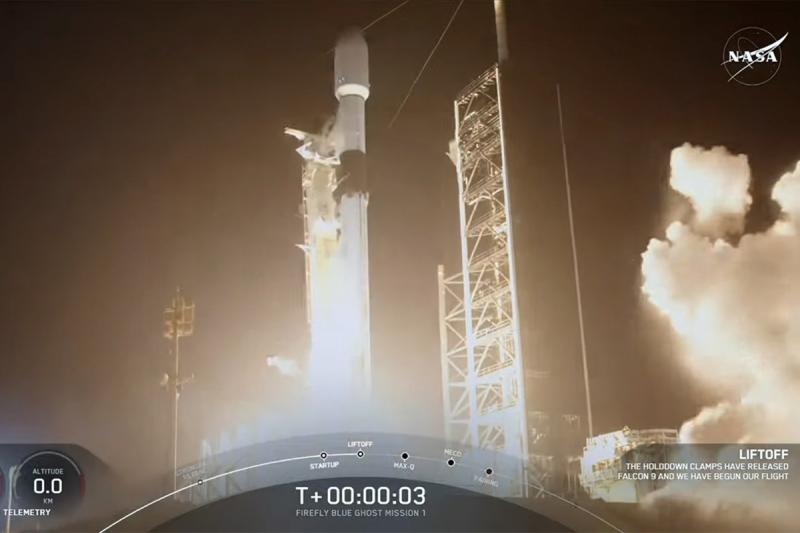Taiwan's National Central University (NCU) announced the successful launch of the country's first lunar mission yesterday, as its Deep Space Radiation Probe (DSRP) was carried into space and is expected to land on the moon in four months.
The DSRP is aboard the lunar lander HAKUTO-R Mission 2 developed by ispace, a Japanese lunar exploration company, and launched from Florida at 2:11pm yesterday via the US space technology company SpaceX's Falcon 9 rocket, NCU said in a statement.
One hour and 32 minutes after takeoff, the lunar lander separated from the launch vehicle.

Photo grab from NASA’s live stream
The DSRP is scheduled to begin operation 36 hours after the launch and NCU's team is set to receive and analyze the data it collects, NCU added.
Featuring the emblem of NCU and the words "Made in Taiwan" on its lower-left corner, the DSRP was Taiwan's first domestically-built scientific payload for a lunar mission and the first to leave low Earth orbit (LEO), which extends to an altitude of 2,000 km, NCU noted.
The DSRP, independently developed by faculty and students of NCU's Department of Space Science and Engineering, weighs only 399 grams but is capable of withstanding stress 33 times its weight and operating under radiation doses exceeding 10 kRads, said Loren Chang (張起維), chair of the department that is leading the lunar mission.
"This project kicked off in 2022 and we went through five different revisions before we got to the version that we felt comfortable watching," Chang told CNA in a phone interview.
The rugged design of the DSRP was necessary as the probe would be traveling to deep space — defined by Chang's team as regions outside of LEO — where the earth's magnetic shield is much weaker, exposing the probe to harsher radiation conditions that could affect technological products, he said.
Additionally, landing on the moon may involve "strong shocks," which would require a robust structure, Chang added.
The mission is aimed at measuring the expected radiation dose between the earth and the moon, as well as on the lunar surface, and understanding the radiation-caused anomalies of electronics commonly used on board a spacecraft, he said.
"By understanding the radiation dose, we can better prepare for missions to the moon and to deep space with human beings," he added.
Asked how he and his team felt after the successful launch, Chang said that they were all "very relieved" as the launch occurred with no delays or cancellations, which are common.
There were several critical stages during a launch, including reaching maximum dynamic pressure and the separation of the spacecraft from the launch vehicle, he said.
"These all went off without a hitch, so we're very, very relieved," he said.
After the successful launch, the lunar lander, carrying the DSRP, is to take a low-energy trajectory to gradually approach the moon, requiring around four months to cover the approximately 400,000km between the earth and the moon, he said.

An essay competition jointly organized by a local writing society and a publisher affiliated with the Chinese Communist Party (CCP) might have contravened the Act Governing Relations Between the People of the Taiwan Area and the Mainland Area (臺灣地區與大陸地區人民關係條例), the Mainland Affairs Council (MAC) said on Thursday. “In this case, the partner organization is clearly an agency under the CCP’s Fujian Provincial Committee,” MAC Deputy Minister and spokesperson Liang Wen-chieh (梁文傑) said at a news briefing in Taipei. “It also involves bringing Taiwanese students to China with all-expenses-paid arrangements to attend award ceremonies and camps,” Liang said. Those two “characteristics” are typically sufficient

A magnitude 5.9 earthquake that struck about 33km off the coast of Hualien City was the "main shock" in a series of quakes in the area, with aftershocks expected over the next three days, the Central Weather Administration (CWA) said yesterday. Prior to the magnitude 5.9 quake shaking most of Taiwan at 6:53pm yesterday, six other earthquakes stronger than a magnitude of 4, starting with a magnitude 5.5 quake at 6:09pm, occurred in the area. CWA Seismological Center Director Wu Chien-fu (吳健富) confirmed that the quakes were all part of the same series and that the magnitude 5.5 temblor was

The brilliant blue waters, thick foliage and bucolic atmosphere on this seemingly idyllic archipelago deep in the Pacific Ocean belie the key role it now plays in a titanic geopolitical struggle. Palau is again on the front line as China, and the US and its allies prepare their forces in an intensifying contest for control over the Asia-Pacific region. The democratic nation of just 17,000 people hosts US-controlled airstrips and soon-to-be-completed radar installations that the US military describes as “critical” to monitoring vast swathes of water and airspace. It is also a key piece of the second island chain, a string of

The Central Weather Administration has issued a heat alert for southeastern Taiwan, warning of temperatures as high as 36°C today, while alerting some coastal areas of strong winds later in the day. Kaohsiung’s Neimen District (內門) and Pingtung County’s Neipu Township (內埔) are under an orange heat alert, which warns of temperatures as high as 36°C for three consecutive days, the CWA said, citing southwest winds. The heat would also extend to Tainan’s Nansi (楠西) and Yujing (玉井) districts, as well as Pingtung’s Gaoshu (高樹), Yanpu (鹽埔) and Majia (瑪家) townships, it said, forecasting highs of up to 36°C in those areas